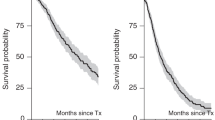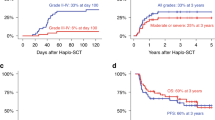Abstract
In multiple myeloma (MM), allogeneic bone marrow transplantation may produce complete and durable responses, but is accompanied by significant transplant-related mortality (TRM). To assess feasibility and possible advantages offered by the use of allogeneic, growth factor-primed PBSC instead of marrow, we analyzed the data of 10 patients with MM (IgG = 6, IgA = 1, BJ = 2, non-secreting = 1; stage II = 1, stage III = 8, plasma-cell leukemia = 1) who received an allogeneic transplant with PBSC. Their age ranged between 35 and 53 years (median 45). All were HLA-identical to their sibling donors. Prior to allograft, six patients received standard-dose chemotherapy (DAV or CY-Dexa) and four a sequential intensified scheme with autologous PBSC support. At the time of transplantation, three patients were in CR, three in PR, three had refractory disease, one progressive disease. Patients were conditioned with busulfan–melphalan (n = 9) or busulfan–cyclophosphamide (n = 1), and were allografted with unmanipulated PBSC obtained by apheresis after treatment with G-CSF alone (n = 6) or GM-CSF followed by G-CSF (n = 4). All patients engrafted, with 0.5 × 109/l PMN and 50 × 109/l platelets on (median) day 13. Four patients had ⩾grade II acute GVHD (grade II in 3, grade III in 1). Following allograft, CR was achieved in 71% patients. Eight are currently alive, with six in CR at a median of 18.5 months (range 7–28) from the transplant. Two patients died, 1 and 4 months from the allograft, respectively, and one is alive with progression. A PCR analysis of IgH rearrangement showed that residual disease was no more molecularly detectable in four out of seven evaluated patients following allograft. The results suggest that PBSC may improve the therapeutic efficacy of allogeneic transplant in MM, not only by a reduction of TRM but also by an improvement of rate and quality of response.
This is a preview of subscription content, access via your institution
Access options
Subscribe to this journal
Receive 12 print issues and online access
$259.00 per year
only $21.58 per issue
Buy this article
- Purchase on Springer Link
- Instant access to full article PDF
Prices may be subject to local taxes which are calculated during checkout
Similar content being viewed by others
Author information
Authors and Affiliations
Rights and permissions
About this article
Cite this article
Majolino, I., Corradini, P., Scimè, R. et al. Allogeneic transplantation of unmanipulated peripheral blood stem cells in patients with multiple myeloma. Bone Marrow Transplant 22, 449–455 (1998). https://doi.org/10.1038/sj.bmt.1701362
Received:
Accepted:
Published:
Issue Date:
DOI: https://doi.org/10.1038/sj.bmt.1701362



